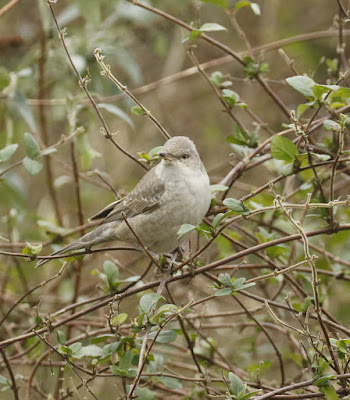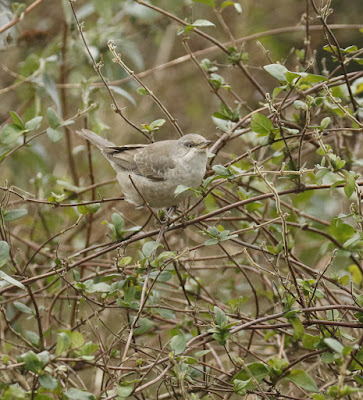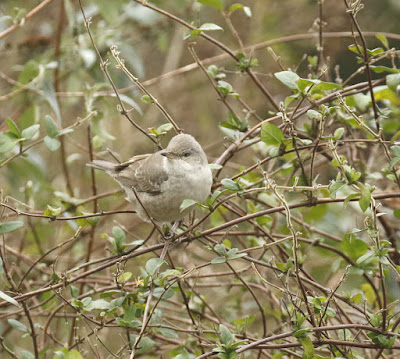Today I headed for the south coast once more, not to Sussex this time but to the neighbouring county of Hampshire and to Titchfield Haven National Nature Reserve in particular.
Titchfield Haven NNR, managed by Hampshire County Council, comprises 369 acres of river, woodland, fields, scrub, marshland, lagoons and scrapes set in the Meon Valley, with the well appointed Visitor Centre (toilets, shop and tearoom) located right by the Solent at Hill Head, where the River Meon runs into the sea. I have seen some good birds here in my time such as a Greater Yellowlegs and not one but two Siberian Stonechats but the reason for my visit today was to see an unseasonably late and exceedingly obliging, juvenile Barred Warbler frequenting a tiny area of garden slap bang behind the Visitor Centre.
Barred Warblers do not breed in Britain but do so on mainland Europe and Scandinavia and are an annual autumn migrant to Britain in numbers varying from 100-200 individuals each year, usually between late August and mid October. This particular Barred Warbler was first encountered on 19th November so it has been at Titchfield Haven for at least seventeen days now. A Barred Warbler in mid November is pretty late but one in December is truly exceptional and who knows if it is going to try and winter here or will eventually move on when the berries, its normal diet in autumn, run out.
After a quite horrendous journey courtesy of congested rush hour roads it was with relief that I parked the car by the seawall and made a short walk past the small marina, with its attendant Mallards, Mute Swans and bickering Black headed Gulls, to Titchfield Haven Visitor Centre. I went in through the gate and around to the back of the Visitor Centre where I joined a dozen or so birders and/or photographers stood against the wall looking at a very small Cotoneaster laden with red berries that was growing against the back wall of a tiny garden opposite us. Everyone was looking intently at the Cotoneaster but try as I might I could not see the focus of their attention which presumably was the Barred Warbler, as most previous reports had indicated this was one of its favourite places. I made a discreet enquiry of a lady photographer to my left and she pointed out the warbler which was virtually invisible, tucked in, almost at ground level on a horizontal twig of the Cotoneaster, virtually up against the wall. It was, until it moved slightly, just a grey smudge hidden behind a tangle of small intermeshed twigs and berries.
We stood for a while and when the warbler moved it became more visible and commenced plucking at the berries but frustratingly never really came fully into the open.
Barred Warblers are the largest of their genus Sylvia, larger than and looking more bulky than say their smaller and similarly featureless cousin the Garden Warbler. Their movements are comparatively slow and they are noted for their clumsy and lethargic actions, sitting for long periods inactive in cover and then feeding with movements that look deliberate and considered rather than the energetic thrusts and flicks of smaller warblers.
Virtually all the Barred Warblers that occur in Britain are found on autumn passage, heading to their tropical East African wintering areas and are invariably juveniles, hatched earlier in the year. The reference books tell one that these juveniles are an unexciting, featureless, dull brownish grey on their upper parts, a paler, buff white on their underparts with a whitish throat and there is no barring at this age except on their undertail coverts and the only other relief from the overall monotony of grey are buff fringes to their wing coverts and flight feathers.They also possess a markedly long tail and dark eye.
Seen close up this individual showed slightly more variation than described above as its underparts were scalloped with brown fringes and in certain lights gave it a scaly appearance and its upperpart feathers were liberally fringed with buff. Its eye was yellow rather than black and its steeply inclined forehead was also noticeable as the crown feathers were often raised almost to a point, generating a distinctive domed profile to its head.
The warbler proceeded to move back along the base of the wall and into, what was soon to become apparent to us, its favourite bush, a Hypericum of thick interlaced stems, twigs and leaves and in which the warbler would secrete itself, just about visible but not so much that it could be successfully photographed. It would hunker down on a twig, preen and then just sit doing very little. It was obviously getting more than enough food which comprised virtually exclusively, as far as I could see of berries; blackberries, cotoneaster, honeysuckle and ivy berries, obtained from the bushes in the garden and nearby.
Finally it moved again and dropped to the ground, hopping along thrush like and picking up fallen berries before flying over a small lane behind the back wall of the garden and into some ivy and bramble covered hawthorns. Five minutes later it re-appeared, very close and to our left, feeding on black honeysuckle berries and giving the best views of the morning.
Five minutes more elapsed and then it vanished. Although we stood and waited for another ninety minutes it never returned to its favourite bushes in the tiny garden.
Many people took the opportunity to leave in its absence and we remaining birders were down to single figures. Finally, I too tired of waiting and walked over the road to the shingle spit opposite the Visitor Centre where a number of small waders were preparing to roost over the high tide, which was now upon us. Restless white and grey Sanderling ran the gauntlet of surf on twinkling black legs whilst a small group of Ringed Plovers, Turnstones and Dunlins, faced into the strengthening wind and slept or stood on the shingle.
I watched and photographed them for half an hour and then made my way back to the Visitor Centre to learn the Barred Warbler had returned to its favourite Hypericum bush and was currently perched, immobile, in the centre of it. I could just about see it through the maze of twigs. Then it stirred, stretched each wing in turn and proceeded to commence preening some more, after which it just sat content, fluffed up and squatting on its secluded perch.
Fifteen minutes later it commenced feeding, repeating its route through the various pieces of vegetation along the wall to end up in the small Cotoneaster at the end, before flying into some ivy covered hawthorns on the other side of the wall and further up the lane. Most of my fellow birders followed but I remained where I was as, by now, I was aware of the warbler's feeding circuit and knew it would always end up back in the Hypericum after a bout of feeding. Sometimes it took longer than other times but I had all day and it always returned.
Sure enough it eventually returned to the bush and settled for another bout of inactivity. I left it there and went in search of sustenance in the tearoom. I already had many acceptable images of the warbler and had been watching it on and off for over four hours so had no anxiety about leaving. A bowl of home made soup, a slice of cake, a skinny mocha and a complimentary mince pie from the very nice lady serving me revived body and soul. I sat and watched out of the tearoom window as a huge container ship made its slow passage up The Solent. I finished my coffee and was all set for another session with the Barred Warbler.
I rejoined a new contingent of birders and photographers who had arrived in my absence and we waited, as before, by the Visitor Centre wall for the warbler still sat in the centre of its favoured bush to do something, anything! It was even asleep briefly before it finally stirred and proceeded to work its way through the bush and along the base of the wall to stop at the Cotoneaster draped over the wall and there it sat for a while before pulling a berry off and swallowing it. Another period of contemplation ensued and then another red berry went down its throat and so it went on for the next few minutes.
It was perched at the very end of the bush and it was now or never. I made my move. My current position did not allow me a clear view of the warbler so I slunk along below the level of the other birders cameras and bins pointing at the warbler in order to position myself beyond it to try for a better angle of view. It chose this very moment to fully come out into the open and seize a berry.
I pressed the camera shutter and fired. Hoping.Then with a flick of its wings it flew fast and low across the path into an adjacent row of bushes on the other side of the path and was soon gone from sight.
It was now three in the afternoon. I had been here, apart from a short break on the beach and another in the tea room, for five and a half hours. It really was time to go, although it had been no hardship, as a Barred Warbler is my kind of bird.
 |
Note the red berried cotoneaster on the wall - a favourite of the Barred Warbler
and the green Hypericum on the extreme left of the picture in which it spent a lotof its time resting and preening |
 |
| Birders waiting for the Barred Warbler to show itself |
 |
| The tiny garden frequented by the Barred Warbler which spent most of its time in various bushes and the cotoneaster. It hardly moved from an area of only 200 metres in extent |
After a quite horrendous journey courtesy of congested rush hour roads it was with relief that I parked the car by the seawall and made a short walk past the small marina, with its attendant Mallards, Mute Swans and bickering Black headed Gulls, to Titchfield Haven Visitor Centre. I went in through the gate and around to the back of the Visitor Centre where I joined a dozen or so birders and/or photographers stood against the wall looking at a very small Cotoneaster laden with red berries that was growing against the back wall of a tiny garden opposite us. Everyone was looking intently at the Cotoneaster but try as I might I could not see the focus of their attention which presumably was the Barred Warbler, as most previous reports had indicated this was one of its favourite places. I made a discreet enquiry of a lady photographer to my left and she pointed out the warbler which was virtually invisible, tucked in, almost at ground level on a horizontal twig of the Cotoneaster, virtually up against the wall. It was, until it moved slightly, just a grey smudge hidden behind a tangle of small intermeshed twigs and berries.
 |
| Barred Warbler |
Barred Warblers are the largest of their genus Sylvia, larger than and looking more bulky than say their smaller and similarly featureless cousin the Garden Warbler. Their movements are comparatively slow and they are noted for their clumsy and lethargic actions, sitting for long periods inactive in cover and then feeding with movements that look deliberate and considered rather than the energetic thrusts and flicks of smaller warblers.
Virtually all the Barred Warblers that occur in Britain are found on autumn passage, heading to their tropical East African wintering areas and are invariably juveniles, hatched earlier in the year. The reference books tell one that these juveniles are an unexciting, featureless, dull brownish grey on their upper parts, a paler, buff white on their underparts with a whitish throat and there is no barring at this age except on their undertail coverts and the only other relief from the overall monotony of grey are buff fringes to their wing coverts and flight feathers.They also possess a markedly long tail and dark eye.
Seen close up this individual showed slightly more variation than described above as its underparts were scalloped with brown fringes and in certain lights gave it a scaly appearance and its upperpart feathers were liberally fringed with buff. Its eye was yellow rather than black and its steeply inclined forehead was also noticeable as the crown feathers were often raised almost to a point, generating a distinctive domed profile to its head.
The warbler proceeded to move back along the base of the wall and into, what was soon to become apparent to us, its favourite bush, a Hypericum of thick interlaced stems, twigs and leaves and in which the warbler would secrete itself, just about visible but not so much that it could be successfully photographed. It would hunker down on a twig, preen and then just sit doing very little. It was obviously getting more than enough food which comprised virtually exclusively, as far as I could see of berries; blackberries, cotoneaster, honeysuckle and ivy berries, obtained from the bushes in the garden and nearby.
Finally it moved again and dropped to the ground, hopping along thrush like and picking up fallen berries before flying over a small lane behind the back wall of the garden and into some ivy and bramble covered hawthorns. Five minutes later it re-appeared, very close and to our left, feeding on black honeysuckle berries and giving the best views of the morning.
Five minutes more elapsed and then it vanished. Although we stood and waited for another ninety minutes it never returned to its favourite bushes in the tiny garden.
Many people took the opportunity to leave in its absence and we remaining birders were down to single figures. Finally, I too tired of waiting and walked over the road to the shingle spit opposite the Visitor Centre where a number of small waders were preparing to roost over the high tide, which was now upon us. Restless white and grey Sanderling ran the gauntlet of surf on twinkling black legs whilst a small group of Ringed Plovers, Turnstones and Dunlins, faced into the strengthening wind and slept or stood on the shingle.
 |
| Sanderling |
Fifteen minutes later it commenced feeding, repeating its route through the various pieces of vegetation along the wall to end up in the small Cotoneaster at the end, before flying into some ivy covered hawthorns on the other side of the wall and further up the lane. Most of my fellow birders followed but I remained where I was as, by now, I was aware of the warbler's feeding circuit and knew it would always end up back in the Hypericum after a bout of feeding. Sometimes it took longer than other times but I had all day and it always returned.
Sure enough it eventually returned to the bush and settled for another bout of inactivity. I left it there and went in search of sustenance in the tearoom. I already had many acceptable images of the warbler and had been watching it on and off for over four hours so had no anxiety about leaving. A bowl of home made soup, a slice of cake, a skinny mocha and a complimentary mince pie from the very nice lady serving me revived body and soul. I sat and watched out of the tearoom window as a huge container ship made its slow passage up The Solent. I finished my coffee and was all set for another session with the Barred Warbler.
I rejoined a new contingent of birders and photographers who had arrived in my absence and we waited, as before, by the Visitor Centre wall for the warbler still sat in the centre of its favoured bush to do something, anything! It was even asleep briefly before it finally stirred and proceeded to work its way through the bush and along the base of the wall to stop at the Cotoneaster draped over the wall and there it sat for a while before pulling a berry off and swallowing it. Another period of contemplation ensued and then another red berry went down its throat and so it went on for the next few minutes.
I pressed the camera shutter and fired. Hoping.Then with a flick of its wings it flew fast and low across the path into an adjacent row of bushes on the other side of the path and was soon gone from sight.
It was now three in the afternoon. I had been here, apart from a short break on the beach and another in the tea room, for five and a half hours. It really was time to go, although it had been no hardship, as a Barred Warbler is my kind of bird.

























No comments:
Post a Comment